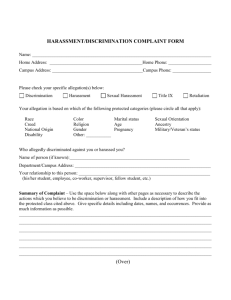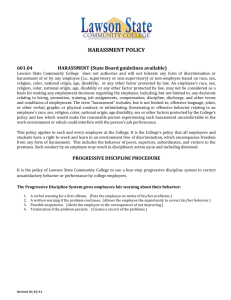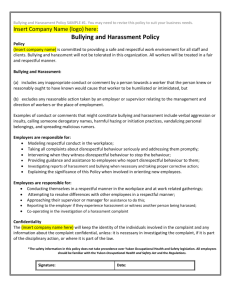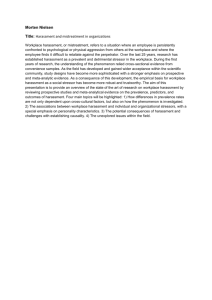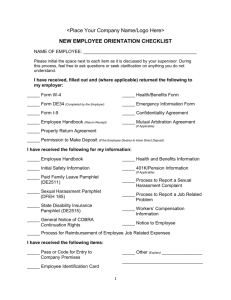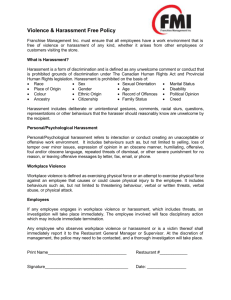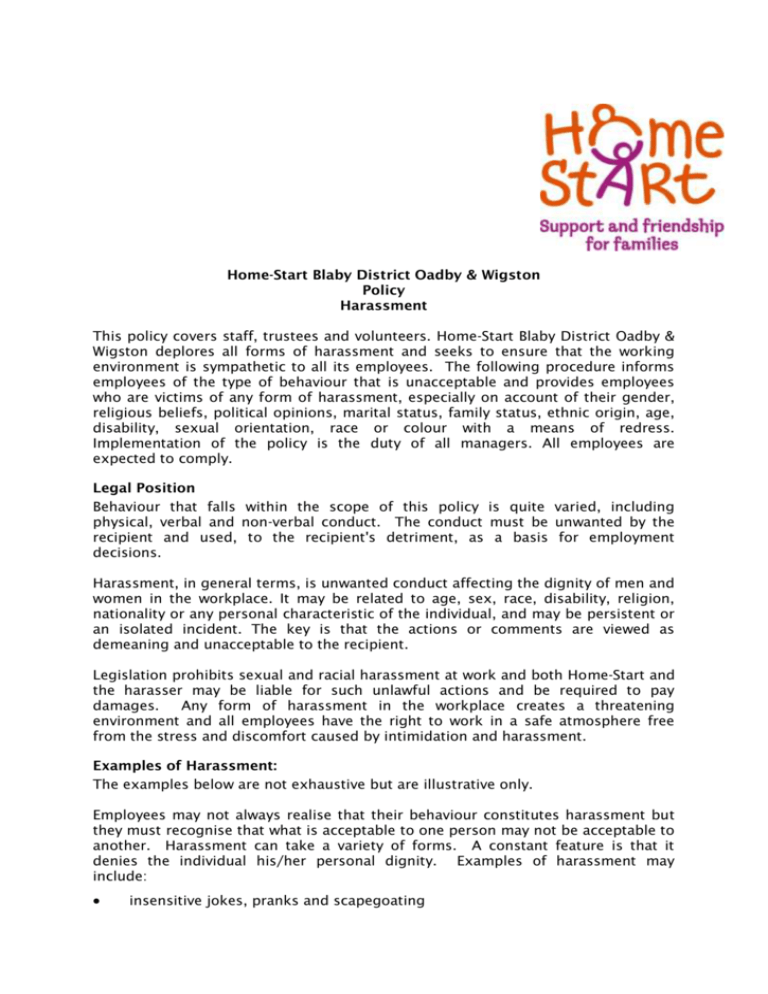
Home-Start Blaby District Oadby & Wigston
Policy
Harassment
This policy covers staff, trustees and volunteers. Home-Start Blaby District Oadby &
Wigston deplores all forms of harassment and seeks to ensure that the working
environment is sympathetic to all its employees. The following procedure informs
employees of the type of behaviour that is unacceptable and provides employees
who are victims of any form of harassment, especially on account of their gender,
religious beliefs, political opinions, marital status, family status, ethnic origin, age,
disability, sexual orientation, race or colour with a means of redress.
Implementation of the policy is the duty of all managers. All employees are
expected to comply.
Legal Position
Behaviour that falls within the scope of this policy is quite varied, including
physical, verbal and non-verbal conduct. The conduct must be unwanted by the
recipient and used, to the recipient's detriment, as a basis for employment
decisions.
Harassment, in general terms, is unwanted conduct affecting the dignity of men and
women in the workplace. It may be related to age, sex, race, disability, religion,
nationality or any personal characteristic of the individual, and may be persistent or
an isolated incident. The key is that the actions or comments are viewed as
demeaning and unacceptable to the recipient.
Legislation prohibits sexual and racial harassment at work and both Home-Start and
the harasser may be liable for such unlawful actions and be required to pay
damages.
Any form of harassment in the workplace creates a threatening
environment and all employees have the right to work in a safe atmosphere free
from the stress and discomfort caused by intimidation and harassment.
Examples of Harassment:
The examples below are not exhaustive but are illustrative only.
Employees may not always realise that their behaviour constitutes harassment but
they must recognise that what is acceptable to one person may not be acceptable to
another. Harassment can take a variety of forms. A constant feature is that it
denies the individual his/her personal dignity. Examples of harassment may
include:
insensitive jokes, pranks and scapegoating
lewd or insulting comments about appearance
unnecessary body contact
displays of racially/sexually/ politically offensive material
requests for sexual favours
speculation about a person’s private life and sexuality
threatened or actual violence
threat of dismissal, loss of promotion etc. for refusal of sexual or other
favours
deliberate exclusion from conversations
abusive, threatening or insulting words and behaviour
displaying abusive writing and pictures
a range of behaviour which is unacceptable to the recipient.
Procedure
Home-Start expects all staff with management responsibility to ensure that this
policy and procedure is adhered to at all times.
Home-Start recognises the sensitive nature of complaints of harassment. Employees
who wish to discuss such complaints in confidence should contact their line
manager, a senior member of staff or a member of the Board of Trustees with
whom they feel comfortable to discuss such matters.
What action should the employee take if s/he feels harassed?
Employees who are being harassed should take the following steps:
1. Ask the harasser to stop or make it clear that the behaviour is unwelcome.
2. In circumstances where it is too difficult for the employee to do this on their
own behalf, they should consider putting their request in writing. The employee
is encouraged to contact their line manager, a senior member of staff or a
trustee in absolute confidence for assistance in making the initial approach.
3. If the initial approach does not result in the harassment ceasing, employees are
advised to bring a formal complaint and should seek assistance from a senior
member of staff in doing so. The complaint should be made in writing to the
Chair of the Board of Trustees and where possible state:
the name of the harasser
the nature of the harassment
dates and times when harassment occurred
names of witnesses to any incidences of harassment
any action already taken by the complainant to stop the harassment.
How will a complaint be handled?
The Chair of the Board of Trustees will designate a trustees or senior member of
staff to handle the complaint. Where the senior member of staff is identified in the
complaint, it will be dealt with by a trustee. Where a trustee is identified it will be
dealt with by another trustee.
An investigation will be carried out as quickly as possible, maintaining
confidentiality at all times. All employees involved in the investigation are expected
to respect the need for confidentiality. Failure to do so will be considered a
disciplinary offence.
If, after an investigation, the person handling the complaint concludes that
harassment has taken place s/he will ensure that the harasser has every opportunity
to defend or explain his/her actions in accordance with the organisation’s
disciplinary procedure.
The severity of the penalty imposed on an employee guilty of harassment will be
consistent with those detailed in the disciplinary procedure (e.g. gross harassment
will normally result in summary dismissal). Where a lesser penalty is appropriate
(e.g. a written warning) this may be coupled with action to ensure that the victim is
able to continue working without embarrassment or anxiety. After discussion with
the victim, the manager may order the transfer of the harasser to a different work
area or arrange for amendment of working practices to minimise contact between
the two employees. The result of the hearing will be confirmed in writing to both
employees.
Where the harassment has come from a trustee the findings of the investigation will
be considered by a group of trustees.
What action to take if you are dissatisfied with the way the complaint has been dealt
with:
a complainant may ask for his/her complaint to be reconsidered by the Chair
of the Board of Trustees. If the chair has been involved in the handling of the
complaint (other than appointing a person to handle the complaint) the
complaint will be addressed to another trustee who has not been so involved.
Requests for reconsideration of the complaint should be made within seven
working days of the first hearing. The decision of the second hearing will be
sent in writing to both parties and will be final
an employee who receives a warning or who is dismissed for harassment may
appeal against the penalty in accordance with the organisation’s disciplinary
and appeal procedure
an employee who brings a complaint of harassment will not suffer
victimisation for having brought the complaint. However, if the complaint is
untrue and has been brought in bad faith (e.g. spite) disciplinary action will be
taken.
Agreed at Board Meeting 29/04/2014
Signed
Date 29th April 2014
To be reviewed within Quality Assurance cycle in relevant standard.
A company limited by guarantee, registered in England & Wales, number 5373629
Charity No 1108617



